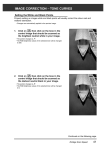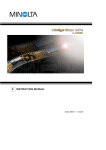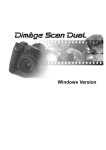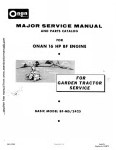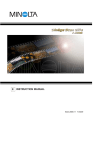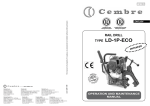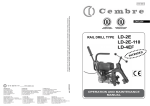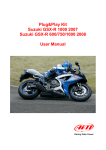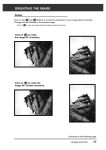Download Minolta DIMAGE SCAN SPEED Instruction manual
Transcript
Thank you for purchasing the Minolta Dimâge Scan Speed. The Dimâge Scan Speed is a dual format film scanner capable of scanning 35mm and, with the optional AD-10 APS Adapter, Advanced Photo System film. This manual has been designed to help you understand the operation of your scanner. Please read this manual thoroughly to realize all the benefits of your scanner. The instructions in this manual assume you have a working knowledge of the operating system for your computer (Macintosh OS, Windows 95, Windows 98, or Windows NT) and its conventions. Familiarity with the mouse and standard operating system menus and commands is necessary before operating the driver software for the Dimâge Scan Speed. This manual does not instruct in the: • basic use of personal computers. • use of Windows 95, Windows 98, Windows NT, or Macintosh OS. • use of Adobe Photoshop, Paint Shop Pro, or Corel Draw. The examples in this manual use Windows 95. The appearance of some screens may differ from the examples when using Windows 98, Windows NT, or the Macintosh operating system. Microsoft, Windows®, Windows 95®, Windows 98®, and Windows NT® are registered trademarks of the Microsoft Corporation. Macintosh™, Apple®, and Power Macintosh® are registered trademarks of Apple Computer, Inc. Adobe® and Photoshop™ are registered trademarks of Adobe Systems Incorporated. Corel Draw™ is a trademark of the Corel Corporation. Paint Shop Pro is the copyright of Met’s Corporation. Other corporate and product names are the trademarks and registered trademarks of their respective companies. • Changes or modifications not approved by the party responsible for compliance could void the user’s authority to operate the equipment. • This manual may not be copied in part or whole without prior written permission from Minolta Co., Ltd. ©1997 Minolta Co., Ltd. • Every necessary caution has been taken to ensure the accuracy of this instruction manual. Please contact us if you have any questions, find any errors, or notice missing information. • Minolta is not responsible for loss, damage, or other results occurring during the operation of this product. This mark certifies that this product meets the requirements of the EU (European Union) concerning interference causing equipment regulations. CE stands for Conformité Européenne. This device complies with Part 15 of the FCC Rules. Operation is subject to the following conditions: (1) This device may not cause harmful interference, and (2) this device must accept any interference received, including interference that may cause undesired operation. To meet FCC regulations, the SCSI cables used with this scanner must be equipped with ferrite cores. This Class B digital apparatus complies with Canadian ICES-0003.. Cet appareil numérique de la classe B est comforme à la norm NMB-003 du Canada. Tested by the Minolta Corporation 101 Williams Drive Ramsey, New Jersey 07446 USA FOR PROPER AND SAFE USE Please read and understand each caution before using this product. CAUTION To avoid fire or electric shock: • Only use the voltage specified for this unit. • Do not expose this unit to liquids. • Do not insert metal objects into this unit. • Do not touch the cord or plug if your hands are wet. • Unplug this unit when it is not in use. Improper use of the power cord may result in fire or electric shock. • Insert the plug securely into an electrical outlet. • Do not pull on the cord. Grasp the plug when removing the power cord from an outlet. • Do not scratch, twist, modify, heat, or place a heavy object on the power cord. • Do not connect the ground to a gas pipe, telephone ground, or a water pipe. Improper grounding can result in electric shock. This product must have sufficient ventilation while in use. Blocked ventilation ducts may cause the unit to overheat, increasing the risk of fire. • Do not use or store this product in dusty or very humid areas. If there is smoke, a strange smell, or any other unusual conditions, shut down and unplug the unit, then contact a Minolta Service Facility. Do not attempt to disassemble this product. It contains high-voltage circuits. Take the product to a Minolta Service facility for repairs. Unexpected damage may occur if this unit is left unattended near young children. Dimâge Scan Speed 1 PACKAGE CONTENTS The following contents should be included in this package. 1. Minolta Dimâge Scan Speed 2. 35mm Slide and Negative holders 3. SCSI cable SC-11 4. AC power cord 5. DS_Speed driver CD ROM 6. Instruction Manual 7. Warranty card 8. Photoshop 4.0 LE CD ROM Software Registration Please register this software before using it… Once registered, you will receive technical support, software upgrade and product information. Complete and return the enclosed Product & Software Registration form after detaching it form the Warranty. No postage is necessary. • The information you provide is confidential and will only be used by Minolta Customer Service and Product Research & Development. 4 TABLE OF CONTENTS FOR PROPER AND SAFE USE . . . . . . . . . . . . . . . . . . . . . . . . . . . . . . . . . . . . . . . . . . . . . .1 SYSTEM REQUIREMENTS PC/AT . . . . . . . . . . . . . . . . . . . . . . . . . . . . . . . . . . . . . . . . . . .2 SYSTEM REQUIREMENTS Macintosh . . . . . . . . . . . . . . . . . . . . . . . . . . . . . . . . . . . . . . . .3 PACKAGE CONTENTS . . . . . . . . . . . . . . . . . . . . . . . . . . . . . . . . . . . . . . . . . . . . . . . . . . . .4 TABLE OF CONTENTS . . . . . . . . . . . . . . . . . . . . . . . . . . . . . . . . . . . . . . . . . . . . . . . . . . . .5 NAMES OF PARTS . . . . . . . . . . . . . . . . . . . . . . . . . . . . . . . . . . . . . . . . . . . . . . . . . . . . . . .6 SCANNER SETUP Setting the SCSI ID . . . . . . . . . . . . . . . . . . . . . . . . . . . . . . . . . . . . . . . . . . . . . . . . . . . . . . . . . . .8 Connecting the Hardware . . . . . . . . . . . . . . . . . . . . . . . . . . . . . . . . . . . . . . . . . . . . . . . . . . . . . .9 Installing the Software PC/AT . . . . . . . . . . . . . . . . . . . . . . . . . . . . . . . . . . . . . . . . . . . . . . . . . .12 Installing the Software Macintosh . . . . . . . . . . . . . . . . . . . . . . . . . . . . . . . . . . . . . . . . . . . . . . .15 STANDARD OPERATION Launching the Software . . . . . . . . . . . . . . . . . . . . . . . . . . . . . . . . . . . . . . . . . . . . . . . . . . . . . . .18 Command Window - Names of Parts . . . . . . . . . . . . . . . . . . . . . . . . . . . . . . . . . . . . . . . . . . .20 Prescan Window - Names of Parts . . . . . . . . . . . . . . . . . . . . . . . . . . . . . . . . . . . . . . . . . . . .21 Setting the Preferences . . . . . . . . . . . . . . . . . . . . . . . . . . . . . . . . . . . . . . . . . . . . . . . . . . . . . . .22 Loading the Film Holder . . . . . . . . . . . . . . . . . . . . . . . . . . . . . . . . . . . . . . . . . . . . . . . . . . . . . .23 Inserting the Film Holder into the Scanner . . . . . . . . . . . . . . . . . . . . . . . . . . . . . . . . . . . . . . . . .25 Setting the Film Type . . . . . . . . . . . . . . . . . . . . . . . . . . . . . . . . . . . . . . . . . . . . . . . . . . . . . . . . .26 Prescan . . . . . . . . . . . . . . . . . . . . . . . . . . . . . . . . . . . . . . . . . . . . . . . . . . . . . . . . . . . . . . . . . .26 Auto-Exposure Lock . . . . . . . . . . . . . . . . . . . . . . . . . . . . . . . . . . . . . . . . . . . . . . . . . . . . . . . . .27 Orienting the Image . . . . . . . . . . . . . . . . . . . . . . . . . . . . . . . . . . . . . . . . . . . . . . . . . . . . . . . . .28 Image Correction . . . . . . . . . . . . . . . . . . . . . . . . . . . . . . . . . . . . . . . . . . . . . . . . . . . . . . . . . . .32 Variations Dialog Box - Names of Parts . . . . . . . . . . . . . . . . . . . . . . . . . . . . . . . . . . . . . . . . .33 Image Correction - Variations . . . . . . . . . . . . . . . . . . . . . . . . . . . . . . . . . . . . . . . . . . . . . . . . . .34 Histogram Dialog Box - Names of Parts . . . . . . . . . . . . . . . . . . . . . . . . . . . . . . . . . . . . . . . .35 Image Correction - Histogram . . . . . . . . . . . . . . . . . . . . . . . . . . . . . . . . . . . . . . . . . . . . . . . . . .36 Tone Curves Dialog Box - Names of Parts . . . . . . . . . . . . . . . . . . . . . . . . . . . . . . . . . . . . . .40 Image Correction - Tone Curves . . . . . . . . . . . . . . . . . . . . . . . . . . . . . . . . . . . . . . . . . . . . . . . .41 Job Type . . . . . . . . . . . . . . . . . . . . . . . . . . . . . . . . . . . . . . . . . . . . . . . . . . . . . . . . . . . . . . . . . .44 Final Scan . . . . . . . . . . . . . . . . . . . . . . . . . . . . . . . . . . . . . . . . . . . . . . . . . . . . . . . . . . . . . . . .46 SCANNING APS FILM Launch Software . . . . . . . . . . . . . . . . . . . . . . . . . . . . . . . . . . . . . . . . . . . . . . . . . . . . . . . . . . . .48 Specify Film Type . . . . . . . . . . . . . . . . . . . . . . . . . . . . . . . . . . . . . . . . . . . . . . . . . . . . . . . . . . .48 Index Window - Names of Parts . . . . . . . . . . . . . . . . . . . . . . . . . . . . . . . . . . . . . . . . . . . . . .48 Preferences - APS Settings . . . . . . . . . . . . . . . . . . . . . . . . . . . . . . . . . . . . . . . . . . . . . . . . . . . .49 APS Adapter - Names of Parts . . . . . . . . . . . . . . . . . . . . . . . . . . . . . . . . . . . . . . . . . . . . . . .50 Loading the APS Adapter . . . . . . . . . . . . . . . . . . . . . . . . . . . . . . . . . . . . . . . . . . . . . . . . . . . . .50 Inserting the APS Adapter into the Scanner . . . . . . . . . . . . . . . . . . . . . . . . . . . . . . . . . . . . . . . .51 Index Scan . . . . . . . . . . . . . . . . . . . . . . . . . . . . . . . . . . . . . . . . . . . . . . . . . . . . . . . . . . . . . . . .52 Prescan and Image Correction . . . . . . . . . . . . . . . . . . . . . . . . . . . . . . . . . . . . . . . . . . . . . . . . .54 Scanning the Image . . . . . . . . . . . . . . . . . . . . . . . . . . . . . . . . . . . . . . . . . . . . . . . . . . . . . . . . .55 Removing the APS Adapter . . . . . . . . . . . . . . . . . . . . . . . . . . . . . . . . . . . . . . . . . . . . . . . . . . . .56 APPENDIX Scan Settings . . . . . . . . . . . . . . . . . . . . . . . . . . . . . . . . . . . . . . . . . . . . . . . . . . . . . . . . . . . . . .58 Scan Settings Dialog Box - Names of Parts . . . . . . . . . . . . . . . . . . . . . . . . . . . . . . . . . . . . . .58 Creating/Deleting Job Files . . . . . . . . . . . . . . . . . . . . . . . . . . . . . . . . . . . . . . . . . . . . . . . . . . . .60 Job File List . . . . . . . . . . . . . . . . . . . . . . . . . . . . . . . . . . . . . . . . . . . . . . . . . . . . . . . . . . . . . . .61 Glossary . . . . . . . . . . . . . . . . . . . . . . . . . . . . . . . . . . . . . . . . . . . . . . . . . . . . . . . . . . . . . . . . . .64 ColorSync . . . . . . . . . . . . . . . . . . . . . . . . . . . . . . . . . . . . . . . . . . . . . . . . . . . . . . . . . . . . . . . . .66 Trouble Shooting . . . . . . . . . . . . . . . . . . . . . . . . . . . . . . . . . . . . . . . . . . . . . . . . . . . . . . . . . . . .67 Specifications . . . . . . . . . . . . . . . . . . . . . . . . . . . . . . . . . . . . . . . . . . . . . . . . . . . . . . . . . . . . . .68 User Technical Support . . . . . . . . . . . . . . . . . . . . . . . . . . . . . . . . . . . . . . . . . . . . . . . . . . . . . . .69 Dimâge Scan Speed 5 SCANNER – NAMES OF PARTS 1. Indicator lamp 2. Film slot 3. Film door 4. Power switch 5. SCSI port - DB25 6. Terminator power switch 7. SCSI ID switches 8. SCSI port - SCSI-1 9. AC socket 6 SCANNER SETUP SETTING THE SCSI ID Turn off the computer and all the devices in the SCSI chain before changing SCSI IDs, connecting, or disconnecting SCSI cables. Hardware damage may occur if this precaution is not followed. A SCSI ID is a unique address you assign to each SCSI device connected to your computer. The SCSI ID range of your computer is from 0 to 7, however some ID's are already occupied. Occupied SCSI ID IBM PC/AT 7 - SCSI host adapter Macintosh 0 - internal hard drive* 3 - internal CD ROM drive** 7 - operating system * IDE Macintosh systems do not use SCSI ID 0 for the hard drive. ** SCSI ID 3 is available on the external bus on Macintosh systems with a dual bus. Setting the SCSI ID 1. Turn off the computer and all connected SCSI devices. 2. Determine which SCSI IDs are not being used. 3. Using a pointed object, set the switches to an unused SCSI ID. • The Dimâge Scan Speed’s SCSI ID is factory preset to 5. If 5 is not occupied, there is no need to change the SCSI ID. • Two operating SCSI devices in the same SCSI chain cannot share a SCSI ID. SCSI ID Dip Switch Settings 8 CONNECTING THE HARDWARE Connecting the SCSI Cable This scanner has been packaged with the SCSI cable SC-11 (DB25-to-SCSI-1). See your dealer if you require a different SCSI cable. • To meet FCC regulations, the SCSI cables used with this scanner must be equipped with ferrite cores. BEFORE YOU BEGIN… TURN THE COMPUTER AND ALL CONNECTED DEVICES OFF. 1. Place the scanner on a level surface. 2. Connect one end of the SCSI cable to either SCSI port on the back of the scanner • Either SCSI port can be used for other configurations, there is no dedicated in or out port. 3. Connect the other end of the SCSI cable to the SCSI port on the computer or the last device in the SCSI chain. Continued on the following page. Dimâge Scan Speed 9 CONNECTING THE HARDWARE If there are other devices in your SCSI chain… 4. Plug the SCSI cable from the next device into the open port on the back of the scanner. 5. Plug the power cord into the scanner’s AC socket, then plug it into a grounded outlet. 10 CONNECTING THE HARDWARE If the Dimâge Scan Speed is the last or only device in your SCSI chain… 4. Turn the terminator power switch (switch 4) to ON. • An external terminator is not necessary with this scanner. Terminating th e SCSI chain helps to supp ress electron ic noise in the S CSI chain. Not terminatin g the SCSI ch ain can cause slow downs, data errors, crashe s, and other unpredictable errors. 5. Plug the power cord into the scanner’s AC socket, then plug it into a grounded outlet. Dimâge Scan Speed 11 INSTALLING THE SOFTWARE – PC/AT WINDOWS 95/ WINDOWS 98 / WINDOWS NT Dimâge Scan Speed for Windows Setup installs the Twain and Twain_32 driver software into the drive and folder you select. • The appearance and/or wording of some dialog boxes may vary depending on the version of Windows running on your machine. • These installation instructions assume drive D is the CD-ROM drive. 1. Turn on the scanner, then turn on the PC. 2. Start the Windows operating system. This step varies with your specific operating software... Windows 95 • The New Hardware Found dialog box will appear. Windows 95 Release 2 (OSR2) and Windows 98 • The Device Wizard dialog box will appear. 3. Click on Cancel. • This dialog box may appear several times. Repeat step 3 until the dialog box no longer appears. 3. Click on Next until the Unknown Device window appears… then click on Finish. • This dialog box may appear several times. Repeat step 3 until the dialog box no longer appears. Windows NT 3. Select Start > Settings > Control Panel, then double-click on the SCSI Adapters icon. Confirm that Minolta #2884 appears as a connected device for your SCSI board. • If Minolta #2884 does not appear, turn the system off and check all the connections. Repeat the procedure. 4. Insert the Dimâge Scan Speed CD-ROM into the CD-ROM drive. 12 INSTALLING THE SOFTWARE – PC/AT 5. Select Run form the Start menu. The Run dialog box will appear 6. Select D:\ENGLISH\Setup.exe from the Open drop-down list, then click on OK. • If your CD-ROM drive is not the D drive, replace the D with the appropriate designation for your CDROM drive. The installer flash will appear. 7. Click on Next The Software License Agreement will appear. 8. After reading the agreement, click on Yes. • If you do not agree to the conditions stated in the End-User License Agreement, click on No and the software will not be installed. The Choose Destination Location dialog box will appear 9. Click on Browse to select another destination directory… • An install directory and path can also be entered directly into the install path list box. then click on Next Continued on the following page. Dimâge Scan Speed 13 INSTALLING THE SOFTWARE – PC/AT The Setup Type dialog box will appear 10. Choose either Typical or TWAIN Files install, then click on Next. The Select Program Folder dialog box will appear. 11. Click on Next. • Setup will begin The Setup Successful dialog box will appear. 12. Click on Close The following dialog box will appear. 13. Click on Yes. 14 INSTALLING THE SOFTWARE – MACINTOSH Please remove or disable any antivirus system extensions before launching this installer. These extensions may conflict with the operation of this installer. Replace or re-enable them when installation is complete. Hold the shift key down during startup to disable the extensions. 1. Turn on the Dimâge Scan Speed, then turn on your Macintosh. 2. Quit any open applications. 3. Insert the Dimâge Scan Speed CD-ROM into the CD-ROM drive. • will appear on the desktop. 4. Double-click on . • The language folders will appear. 5. Open the English language folder, then double click on the Dimage Scan Speed Installer. The installer’s start-up screen will appear. 6. Click on . The End-User License Agreement will appear. 7. Click on . • If you do not agree to the conditions stated in the End-User License Agreement, click on Decline and the software will not be installed. Continued on the following page. Dimâge Scan Speed 15 INSTALLING THE SOFTWARE – MACINTOSH The following dialog box will appear. Install type pulldown menu Install location pulldown menu Name and icon of the selected install drive or folder. 8. Select the install drive (or folder) and type from the pulldown menus. • You can also click on to select an install drive. 9. Click on . The following message appears when the installer is finished. 11.Click on . • The software will be installed in a new folder titled Dimage Scan Speed. • If Easy Install was chosen, the Dimage Scan Speed folder will contain the following items: DS_Speed Utility, DS_Speed Plugin, and Read Me file. 11. Drag the DS Speed Plug-in to the Import/Export folder in the Adobe Photoshop Plug-ins folder. 16 S TA N D A R D O P E R AT I O N SCAN FLOW Launch the Software Set the Preferences Load the Film Holder Insert the Film Holder Specify the Film Type Prescan Orient the Image Correct the Brightness, Contrast, and Colour Specify the Job Type Scan Save LAUNCHING THE SOFTWARE The TWAIN driver lets you control the software through another application, such as your image editing software. Launching the TWAIN Driver — Windows This manual uses Adobe Photoshop 4.0.1 as the host application. Commands may vary among applications. 1. Open the host application. 2. Select File > Import > Select TWAIN_32 Source... The Select Source dialog box appears. 3. Select DS_Speed, then click on Select. 4. Select File > Import > TWAIN_32. The software is ready for use when the Command window appears (p.20). 18 LAUNCHING THE SOFTWARE The plug-in software lets you access the software through Adobe Photoshop. Launching the Plug-in — Macintosh 1. Launch Adobe Photoshop. 2. Photoshop 4.0.1 and newer: Select File > Import > DS_Speed Plug-in. Photoshop 3.0.5: Select File > Acquire > DS_Speed Plug-in The software is ready for use when the Command window appears (p.20). Launching the Utility Software Windows Select Start > Programs > Minolta Dimage Scan Speed > DS Speed Utility Macintosh Double click on . The software is ready for use when the Command window appears (p.20). Dimâge Scan Speed 19 COMMAND WINDOW – NAMES OF PARTS 20 Index Scan button (APS p. 52) Rewind button (APS p. 56) Prescan button Help button ( Scan button Status bar Scan Settings button Load Job button Save Index Scan button Displays current Job selection Save Job button Film Type list box Preferences button Film Format list box on Macintosh) PRESCAN WINDOW – NAMES OF PARTS Zoom button Variations button Flip Vertical button Histogram button Rotate Right button Reset All button Rotate Left button Cropping frame dimensions Flip Horizontal button RGB/CMY display Full-Screen View button Tone Curves button AEL button Image area Grab button Dimâge Scan Speed 21 SETTING THE PREFERENCES 1. Click on . 2. Set the preferences as desired. Auto Expose Slides checkbox Select this checkbox when scanning underexposed slides. Close Driver After Scanning checkbox Closes the scanner's driver software after the scan is complete. Prescan Size list box There are three size options for prescan window: Small, Large, and Auto. • Auto determines the appropriate prescan window size based on the size of your monitor. Colour Depth list box The pixel depth of each colour channel used to scan your image (RGB or CMY). Three options are available: • 8-bit – over 16.7 million colours • 16-bit – over 2.8 billion colours • 16-bit linear – same as 16 bit, but image correction is not applied when the image is scanned. 3. Click on settings. to accept the new preference • Changes to the Preference settings take effect immediately. 22 LOADING THE FILM HOLDER Using the included 35mm negative and slide holders, the Minolta Dimâge Scan Speed can scan mounted or unmounted… • 35mm colour negatives • 35mm black & white negatives • 35mm colour slides • 35mm black & white positives Advanced Photo System negatives and slides can also be scanned using the optional AD-10 APS Adapter. See page 48. Loading the Negative Holder 1. Open the film holder. 2. Place the film in the film holder emulsion side down. • The film holder will accept film strips up to 6 frames long. • Brush dust off the film before placing it into the film holder. The frame nu mbers and text are backw ards when the film’s emul sion side is up. 3. Align the frames within the scanning windows. 4. Snap the film holder closed. Continued on the following page. Dimâge Scan Speed 23 LOADING THE FILM HOLDER Loading the Slide Holder 1. Insert slides into the slide holder emulsion side down. • Brush dust off the the slide before placing it into the film holder. • Slide mounts must be thicker than 1 mm and thinner than 2 mm to fit into the slide holder. • Orient the slides horizontally, not vertically. Do not scan g lass mounted slide s. Glass mounts bend the light from the line scanner, producing ba d results. 24 INSERTING THE FILM HOLDER INTO THE SCANNER The notches in the film and slide holders identify the position of the scanning windows. Push the holder in all the way in to scan the last frame on that side of the film holder. Remove, flip, then re-insert the film holder to scan the frames on the other side of the holder. Insert the negative holder into the scanner’s film slot to scan frames 1, 2, or 3. • Frames 1 or 2 with the slide holder. The white should be up rig mark ht. Remove, flip, then re-insert the negative holder to scan frames 4, 5, or 6. • Frames 3 or 4 with the slide holder. • The blue mark should be upright Dimâge Scan Speed 25 SETTING THE FILM TYPE / PRESCAN Setting the Film Type 1. Select 35mm from the film format drop-down list. • The Prescan window appears. 2. Select the film type from the film type drop-down list. 3. Click on in the Command window. The prescanned image will appear in the Prescan window. Press Ctrl wh en prescanning ( on the Macintosh ) to see CMY values in the RGB/CMY dis play. 26 AUTO-EXPOSURE LOCK Especially useful when scanning bracketed exposures, AE lock lets you scan multiple images with the same initial exposure settings. AE Lock saves the automatic exposure settings determined when an image is prescanned. Subsequent images are prescanned using the ‘locked’ exposure settings. • AE-lock does not save exposure corrections made in the Variations, Histogram, or Tone Curves dialog boxes. Setting AE-Lock After prescanning the image… 1. Click on • . can not be selected until an image has been prescanned. 2. Select another image, then click on . • The scanner skips the setting exposure step in the prescan sequence. Images will be scanned using the AE lock settings until AE lock is cancelled or the scanner is reinitialized. Cancelling AE-Lock 1. Click on 2. Click on . to prescan the image again. Dimâge Scan Speed 27 ORIENTING THE IMAGE Rotate Click on the and buttons to correct the orientation of your image before scanning. Changes will be reflected in the prescan image. • Click on to view a full screen display of the area inside the cropping frame. Click on to rotate the image 90° clockwise. Click on to rotate the image 90° counter-clockwise. 28 ORIENTING THE IMAGE Flip The and buttons let you flip the image left to right or top to bottom before scanning. Changes will be reflected in the prescan image. • Click on Click on to view a full screen display of the area inside the cropping frame. to flip the image top to bottom. • The image is upside down compared to the original prescan. Click on to flip the image left-to-right. • Image is backwards compared to the original scan. Dimâge Scan Speed 29 ORIENTING THE IMAGE Cropping The cropping frame defines how much of the prescan image will be scanned. The dimensions of the cropping frame are displayed in the lower left corner of the prescan window • Click on to view a full screen display of the area inside the cropping frame. To enlarge or reduce the size of the cropping frame… Click on the cropping frame and drag the pointer in or out. • Click on the corners and drag to resize the cropping frame proportionally. • Click on the sides and drag to resize the cropping frame non-proportionally. To move the cropping frame… Click inside the cropping frame, then drag the cropping frame to its new location. To define a new cropping frame… Click and drag outside the current cropping frame. 30 ORIENTING THE IMAGE Magnifying or Reducing the View Use the zoom button to increase or reduce the image magnification. Zooming In 1. Click on in the Prescan window. • The pointer will change to . 2. Click anywhere on the image to zoom in. • The clicked position will be the center of the magnified view in the Prescan window. • The + disappears from the magnifier icon when the maximum image magnification has been reached. Zooming Out 1. Press and hold the Ctrl key (option key on the Macintosh) to reduce the image magnification. • The pointer will change to . 2. Click anywhere on the image to zoom out. • The – disappears from the magnifier icon when the minimum image magnification has been reached. Scroll Use the grab button to scroll an enlarged image. • can only be selected when the image has been magnified beyond the limits of the Prescan window. 1. Click on in the Prescan window. • The pointer will change to . 2. Click on and drag the image to the desired location Dimâge Scan Speed 31 IMAGE CORRECTION This scanner gives you three options for correcting the brightness, contrast, and colour balance of the final scan Variations This is the easiest way to make image corrections and is recommended for beginners. Simply choose the image that looks best from a visual display of contrast and brightness differences. Click on slider bars to correct the colour A control (uncorrected) and preview (corrected) image appear in the Variations dialog box for comparison. Histogram The Histogram dialog box gives a graphical representation of the 256 brightness levels for the red, green, and blue colour channels. Using sliders, the input and output levels can be adjusted to make changes in the brightness, overall contrast, gamma (midtone contrast), and the colour of the image. A control and preview image appear in the Histogram dialog box for comparison. Tone Curves The Tone Curves dialog box displays correction curves for the red, green, and blue colour channels. Change the brightness, contrast, gamma and colour of the output image by changing the shape of the correction curves. A control and preview image appear in the Tone Curves dialog box for comparison. Reset All – Prescan Window The Reset All button in the Prescan window cancels all corrections applied in the Variations, Histogram, and Tone Curves dialog boxes. Colour, brightness, and contrast settings are returned to their prescan values. 32 IMAGE CORRECTION – VARIATIONS The Variations dialog box lets you quickly correct the brightness and contrast of your image by clicking on simulations that represent varying amounts correction to your image. Correct the colour in your image by clicking on the appropriate colour slider. • Click on to view a full screen display of the control and prescan windows. 1. Click on in the prescan window. The Variations Dialog Box — Names of Parts Grayscale Brightness slider RGB sliders Image simulation windows Control image Preview image Full-screen display button Reset button Help button Cancel button Contrast-level slider OK button Status window Dimâge Scan Speed 33 IMAGE CORRECTION – VARIATIONS Adjusting the Brightness and Contrast The image simulation windows map contrast and brightness changes to the preview image. The windows display a one step change in the brightness and contrast, but up to 10 steps (+/-) can be applied. The selected colour, brightness, and contrast changes are automatically applied to the preview image 2. Click on the appropriate window or move the sliders to increase or decrease the contrast and/or brightness. • The changes are automatically applied to the preview image. • Additional contrast and brightness simulations will be mapped around the center image. Correcting th e brightness and contrast may eliminate the need for colour correct ions. Adjusting the Colour 3. Adjust the colour balance as necessary by clicking on the R, G, and B sliders. • R can subtract red (left arrow) or subtract cyan (right arrow). • G can subtract green (left arrow) or subtract magenta (right arrow). • B can subtract blue (left arrow) or subtract yellow (right arrow). Applying the Corrections 4. Click on scan. to apply the changes to your • Click on to cancel all corrections and start over. • Click on corrections. to close the variations window without applying any 34 IMAGE CORRECTION – HISTOGRAM The histogram dialog box displays the frequency of occurrence of the 256 levels of brightness (0-255) for each of the colour channels that make up the image area inside the cropping frame. Level 0 is minimum brightness (black). Level 255 is maximum brightness (white). The midtones fall in-between. • The histograms represent the red, green, and blue brightness levels for the control image. Click on to view the histograms for the preview image. Click on and hold in the prescan window. The Histogram Dialog Box — Names of Parts Control image Save settings button White point button Shadow sliders Black point button Midtone slider Gray point button Highlight sliders Output histogram button Output level sliders RGB synchro button Input level sliders Load settings button Preview image Dimâge Scan Speed 35 IMAGE CORRECTION – HISTOGRAM Setting the White, Black, and Gray Points Properly setting an image’s white and black points will usually correct the colour cast and midtone distribution. Properly setting the gray point will correct the colour balance. • Changes are automatically applied to the preview image. 1. Click on , then click on the tone in the control or prescan image that should be scanned as the brightest neutral white in your image. • The pointer will change to . • The RGB brightness values of the selected tone will be changed to 255. 2. Click on , then click on the tone in the control or prescan image that should be scanned as the darkest neutral black in your image. • The pointer will change to . • The RGB brightness values of the selected tone will be changed to 0. 3. Click on , then click on the tone in the control or prescan image that should be scanned as a neutral tone. • The pointer will change to . • The colour balance of the image is shifted to make the selected tone neutral. • The selected tone’s brightness value does not change. 36 Setting the gr ay point is not necess ary for most images. IMAGE CORRECTION – HISTOGRAM Brightness and Contrast Changes - RGB Synchro When RGB synchro is selected, moving the levels sliders remaps the pixel values without changing the colour balance. Correcting the highlight and shadow values with the histogram sliders, may produce better results on images without neutral highlights or shadows. If the histogram contains large flat line areas… 1. Click on . • Changes applied to one colour channel will be reflected in the other two. 2. Click on and move the input level highlight and shadow sliders to the edges of the flat line area. Input Level Histograms • Changes are automatically applied to the preview image. • Values to the right of the highlight slider will be scanned as pure white (level 255). Values to the left of the shadow slider will be scanned as pure black (level 0). Input level highlight sliders moved to the edge of the flat line area. 3. Click on and slide the output level sliders until the preview image has the desired image contrast. • Click on to view a full screen display of the control and preview windows. 4. Click on and hold to view the output level histograms. Output Level Histograms The brightness level for the curren tly selected slide r is displayed nex t to the histogram. Pixel values have been spread to better utilize the brightness range. Continued on the following page. Dimâge Scan Speed 37 IMAGE CORRECTION – HISTOGRAM Colour Balance Adjustment - Individual Channels Changing the slider positions for individual channels affects the colour balance of the output image. 1. Click on to deselect RGB Synchro. Input Level Histograms 2. Click on and move the R, G, and B sliders to the desired locations. • Changes are automatically applied to the preview image. • Click on to view a full screen display of the control and preview windows. The red input level highlight slider is moved to the edge of the red flat line area. 3. Click on and hold to view the output level histograms. Output Level Histograms Only the red pixel values have been remapped. Remapping the values of a single colour channel usually affects the colour balance. Applying or Cancelling Corrections Click on to apply or to cancel the corrections to the image being scanned. 38 IMAGE CORRECTION – HISTOGRAM Saving and Loading Histogram Settings Histogram settings can be saved as a data file that can be loaded and applied to other images. Save Settings 1. Click on . • The histogram settings are saved to a data (dat) file. The save file dialog box will appear. 2. Enter a file name and the location to save the file, then click on . Load Settings 1. Click on . The open file dialog box will appear. 2. Select the settings file you want to use, then click on . • The settings in the selected file are applied to the current image. The histogram settings files for colour and bl ack and white film are not interchangea ble. Dimâge Scan Speed 39 IMAGE CORRECTION – TONE CURVES The Tone Curves dialog box displays curves for the prescanned image inside the cropping frame. The curve represents the input brightness values (x-axis) in relation to the output values (y-axis). This dialog box allows you to make changes to the tone curves. It is possible to make changes to the individual curves for each channel; red (R), green (G), and blue (B), or to make changes to the overall curve (RGB curve). • The right side of the curve affects highlights, the left side of the curve affects shadows, and the midtones fall in between. Brightness values are 0 (black) at the bottom of the grid, 255 (white) at the top of the grid, and the middle values fall in between. Click on in the prescan window. Tone Curves Dialog Box — Names of Parts The curves dialog box will appear. Control image Calculate button Colour channel list box Output brightness value White point button Input brightness value Black point button Preview image Free curve button 40








































